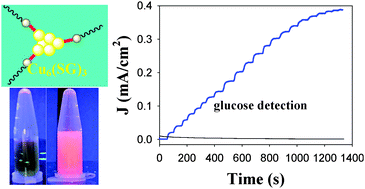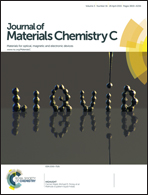Sub-nanometer sized Cu6(GSH)3 clusters: one-step synthesis and electrochemical detection of glucose†
Abstract
We report here a one-pot synthesis of sub-nanometer sized copper clusters capped with a water-soluble ligand, L-glutathione (SGH), through a chemical reduction process. The composition of the as-prepared Cu6(SG)3 nanoclusters was confirmed by electrospray ionization mass spectrometry (ESI-MS) and matrix-assisted laser desorption ionization time-of-flight mass spectroscopy (MALDI-TOF MS). The FTIR, 1H NMR and XPS characterization methods showed that with the production of Cu6(SG)3 clusters and the formation of Cu–S bonds, the surface chemical environment of the clusters exhibited a significant change. The produced water-soluble clusters show aggregation-induced fluorescence upon the addition of ethanol into the cluster aqueous solution. By loading on the TiO2 support, the as-prepared copper nanoclusters were successfully applied to the electrochemical detection of glucose. Compared to large Cu nanoparticles, the Cu6(SG)3 nanoclusters exhibited higher sensitivity and a wider linear range for glucose detection.

- This article is part of the themed collection: 2015 Journal of Materials Chemistry C Hot Papers

 Please wait while we load your content...
Please wait while we load your content...